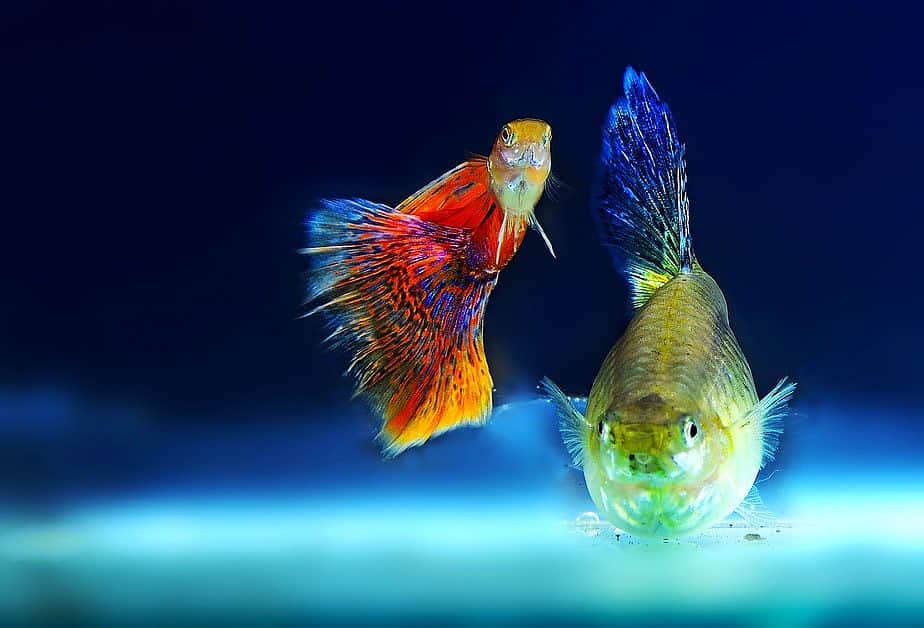
Even generally compatible fish species can nip each other’s fins and tails. So, why do fish bite each other?
Fish often bite others’ fins and tails due to stress, which can be related to overcrowding, suboptimal water quality, or other environmental conditions. Due to genetic traits, some fish species are likelier to nip their tankmates with long fins and tails, even without particular stressors. Fin-nippers commonly include danios, bettas, and tetras. In this case, the fish should not be kept in the same tank as fish with long fins and tails.
COMMON CAUSES AND TRIGGERS OF FIN AND TAIL NIPPING
Some Species of Fish Are Prone to Nipping
Some kinds of fish are predisposed to nipping fins and tails in response to multiple triggers. The presence of another fish with long tails or fins is a trigger, even if the aquarium conditions are perfect otherwise.
Among the most popular fin nippers are bettas, most tetras, angelfish, and tiger barbs.
To address aggressive and defensive behaviors in your fish:
- Avoid overcrowding the tank
- Consider which part of the tank in which the fish likes to dwell. If you have one species of bottom dwellers, one of the middle dwellers, and one of the top dwellers, you are more likely to have a happy aquarium than if you have three top-dwelling species.
- Avoid adding too many new fish at a time.
Ample tank space and ideal water conditions can be a buffer against mouthy behavior. However, it is important to avoid placing such pet fish in the same aquarium as long-finned and long-tailed fish.
Stressor Can Trigger Nipping
The environment in the tank should replicate the conditions of the natural habitat of your pet fish as closely as possible.
In nature, fish either migrate or become ill when something in the water is suboptimal to their well-being. As pets, fish stay in the aquarium as long as they can survive.
Stress caused by something in the environment can cause a behavior change. It is common for fish to become more territorial and aggressive under stress, and nipping a tankmate’s fin would be an expression of that change.
Some of the common stressors that could cause behavioral changes are the following:
- The water in the tank is too warm or too cold
- Too many fish in the tank
- Noise
- Being positioned too close to a direct source of light
- Being positioned in a high-traffic area in the house
- A sudden change in the environment, for example, if you change all the water at once
If fish become physically ill or if they do not get proper nutrition, that could also make them behave aggressively.
Poor Water Quality
Fish are susceptible to poor water quality, and fin nipping can result from suboptimal aquarium conditions.
In addition to needing a certain temperature range and stability, fish require the right bacterial composition.
- Avoid changing too much water at a time to prevent disturbing the established environment.
- Do not just top off the water but perform water changes to remove waste and toxins.
- It is important to have a water filter and to perform partial water changes. One does not substitute the need for the other.
- Dechlorinate as needed. When you prepare a new aquarium, dechlorinating is essential.
- Avoid putting more food than what the fish can eat within about 3 minutes to prevent the accumulation of waste.
Overcrowding
Overcrowding is a major stressor, and a very common one.
Adding new fish to an aquarium is an exciting event for so many pet fish owners. It is fun to choose new fish and to watch them explore the aquarium and interact with each other. Watching fish can be therapeutic. In other words, it is tempting to add more fish.
Many owners add too many specimens of different species in their aquariums, thus making problems almost unavoidable.
Top vs Middle vs Bottom Dwelling Fish
Fish live in different layers of the aquarium, and keeping the species that are not likely to get in each other’s way is essential.
Adding Clown Killifish to a tank with a Betta could cause some issues because both are surface dwellers, although not aggressive. If you add a few bottom-dwelling, docile Asian Stone Catfish or Pygmy Sunfish, the two species will not bother each other and will likely coexist peacefully.
Schooling Fish
Some fish, including tetras and danios, are categorized as schooling fish and they need to live in groups of more than 2 specimens in a tank, provided there is sufficient room, of course.
Usually, groups of 6-10 are preferred. If fish are not able to form groups, they may feel vulnerable, although there are not the usual threats they face in their natural habitats. Feeling insecure can cause aggression.
Unbalanced Male-to-Female Ratio
The ideal ratio depends on the species of fish you have but having more males than females is very likely to lead to aggression in most fish types. A few females can typically coexist peacefully.
Long-Finned Fish And Territorial Fish In One Tank
Regardless of the types of fish in your aquarium, if you have some fish with long fins and tails and a type of fish that is generally aggressive, the combination makes fin-nipping likely.
DO FINS GROW BACK AFTER BEING NIPPED?
Nipped fins and tails can grow back if your fish is healthy and the aquarium provides a good environment to recover. The process can take weeks or months.
It is important to observe the healing of the fin because the affected fin is prone to infection, especially shortly after the nipping incident.
The fin or the tail might look different when it heals and grows back, as there can be some scarring and remodeling at the site.
FIN ROT
If the site does not heal well, fin rot could develop. It is treatable but some fish get sick and weakened and can even die from the injury. The infection could spread to other fish in the aquarium, too.
Fin rot is commonly caused by gram-negative bacteria Pseudomonas, Aeromonas, and others. These bacteria are present in the environment in small amounts and the site of injury is an opportunity for their growth.
You may first notice discoloration on the edges of the fins, they could turn greyish. Then the site develops some inflammation and possibly bleeding. Eventually, the affected part of the fin becomes necrotic and falls off.
To treat fin rot, you can use commercial cleaning remedies. API Fin And Body Cure is fish powder medication, and it is dissolved directly in the water. It can only be used for freshwater aquariums.
Advanced fin rot has to be treated with an antibacterial ointment recommended or prescribed by a veterinarian.
To Conclude
Fin nipping is a common issue and it does not usually cause serious problems unless it is frequent and aggressive. If some fish bully others consistently and forcefully, the victim can experience distress and develop infections.
If you have addressed any potential problems in the environment of the aquarium, and some specimens are still aggressive, then they may need to be separated from other fish in your aquarium.
Recent Posts
Eating one's offspring is not uncommon in fish and other organisms. So, why do fish sometimes eat their eggs and fry? Fish eat their eggs and babies to improve the chances of survival for at least...
If you are looking for relatively easy-to-care-for pet fish with minimal equipment, there are fish species that can thrive at room temperature and in a small aquarium. Several coldwater fish...

